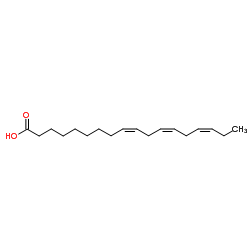Linolenic acid

Linolenic acid structure
|
Common Name | Linolenic acid | ||
|---|---|---|---|---|
| CAS Number | 463-40-1 | Molecular Weight | 278.430 | |
| Density | 0.9±0.1 g/cm3 | Boiling Point | 443.4±0.0 °C at 760 mmHg | |
| Molecular Formula | C18H30O2 | Melting Point | -11 °C(lit.) | |
| MSDS | Chinese USA | Flash Point | 275.7±14.4 °C | |
|
Structural insights into methanol-stable variants of lipase T6 from Geobacillus stearothermophilus.
Appl. Microbiol. Biotechnol. 99 , 9449-61, (2015) Enzymatic production of biodiesel by transesterification of triglycerides and alcohol, catalyzed by lipases, offers an environmentally friendly and efficient alternative to the chemically catalyzed process while using low-grade feedstocks. Methanol is utilize... |
|
|
Induction of Hepatic and Endothelial Differentiation by Perfusion in a Three-Dimensional Cell Culture Model of Human Fetal Liver.
Tissue Eng. Part C Methods 21 , 705-15, (2015) The development of functional engineered tissue constructs depends on high cell densities and appropriate vascularization. In this study we implemented a four-compartment three-dimensional perfusion bioreactor culture model for studying the effects of medium ... |
|
|
Determining fatty acids by desorption/ionization mass spectrometry using thin-layer chromatography substrates.
Anal. Bioanal. Chem 407 , 4513-22, (2015) In this study, we demonstrate the application of ambient mass spectrometry for measuring fatty acids from various biological sample matrices such as olive oil, fish oil, salmon, and human serum. Optimum performance was obtained after spotting samples onto thi... |
|
|
Direct detection of free fatty acids in edible oils using supercritical fluid chromatography coupled with mass spectrometry.
Food Chem. 170 , 463-9, (2014) Determination of free fatty acids (FFAs) in food products is of enormous interest mainly because they are related to the quality and authenticity of the oils. In this study, supercritical fluid chromatography (SFC), followed by an electrospray ionisation trip... |
|
|
Developmental changes in leaf phenolics composition from three artichoke cvs. (Cynara scolymus) as determined via UHPLC-MS and chemometrics.
Phytochemistry 108 , 67-76, (2014) The metabolomic differences in phenolics from leaves derived from 3 artichoke cultivars (Cynara scolymus): American Green Globe, French Hyrious and Egyptian Baladi, collected at different developmental stages, were assessed using UHPLC-MS coupled to chemometr... |
|
|
Preventive effects of a fermented dairy product against Alzheimer's disease and identification of a novel oleamide with enhanced microglial phagocytosis and anti-inflammatory activity.
PLoS ONE 10(3) , e0118512, (2015) Despite the ever-increasing number of patients with dementia worldwide, fundamental therapeutic approaches to this condition have not been established. Epidemiological studies suggest that intake of fermented dairy products prevents cognitive decline in the e... |
|
|
Direct Derivatization vs Aqueous Extraction Methods of Fecal Free Fatty Acids for GC-MS Analysis.
Lipids 50 , 681-9, (2015) A comprehensive and accurate determination of free fatty acids (FFA) is required for fecal metabolomic investigations. The present study compares three aqueous extraction methods (1) ULTRA-TURRAX(®), (2) whirl mixing and (3) basic ULTRA-TURRAX extraction of f... |
|
|
Profiling Chlamydomonas metabolism under dark, anoxic H2-producing conditions using a combined proteomic, transcriptomic, and metabolomic approach.
J. Proteome Res. 13(12) , 5431-51, (2014) Chlamydomonas reinhardtii is well adapted to survive under different environmental conditions due to the unique flexibility of its metabolism. Here we report metabolic pathways that are active during acclimation to anoxia, but were previously not thoroughly s... |
|
|
Short-term oral atrazine exposure alters the plasma metabolome of male C57BL/6 mice and disrupts α-linolenate, tryptophan, tyrosine and other major metabolic pathways.
Toxicology 326 , 130-41, (2014) Overexposure to the commonly used herbicide atrazine (ATR) affects several organ systems, including the brain. Previously, we demonstrated that short-term oral ATR exposure causes behavioral deficits and dopaminergic and serotonergic dysfunction in the brains... |
|
|
Nutrients differentially regulate nucleobindin-2/nesfatin-1 in vitro in cultured stomach ghrelinoma (MGN3-1) cells and in vivo in male mice.
PLoS ONE 9(12) , e115102, (2014) Nesfatin-1 is secreted, meal-responsive anorexigenic peptide encoded in the precursor nucleobindin-2 [NUCB2]. Circulating nesfatin-1 increases post-prandially, but the dietary components that modulate NUCB2/nesfatin-1 remain unknown. We hypothesized that carb... |